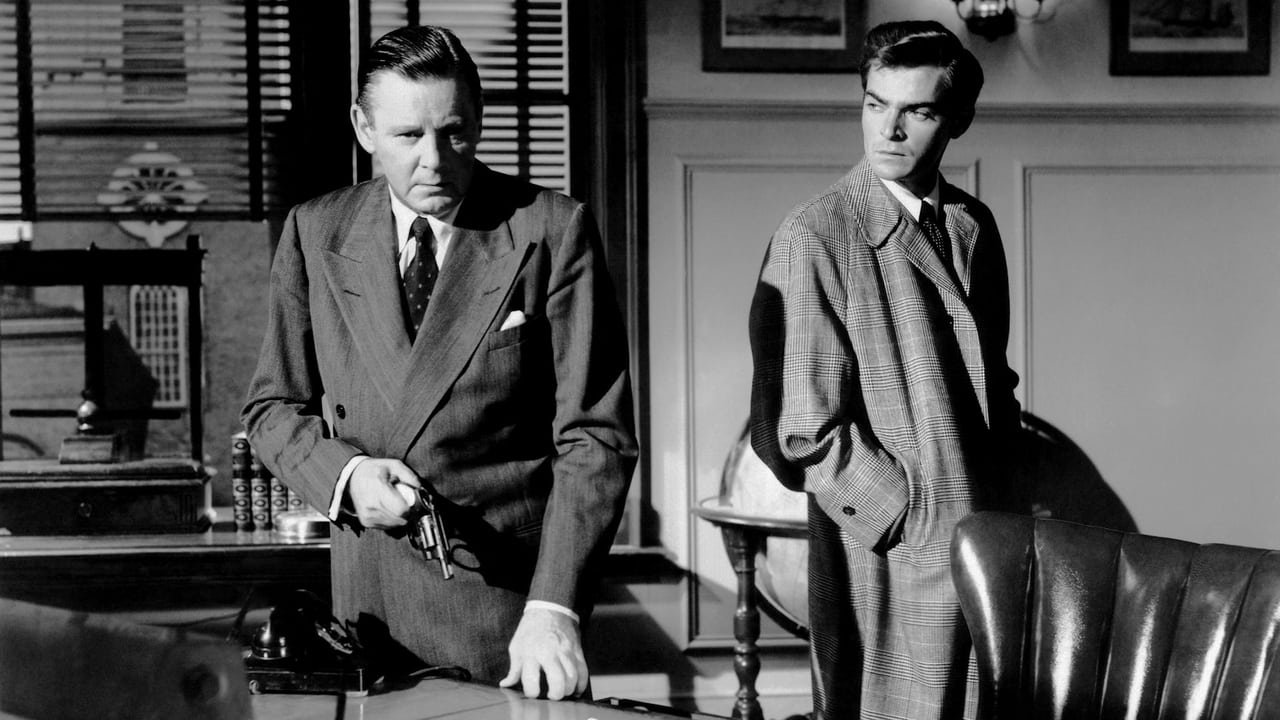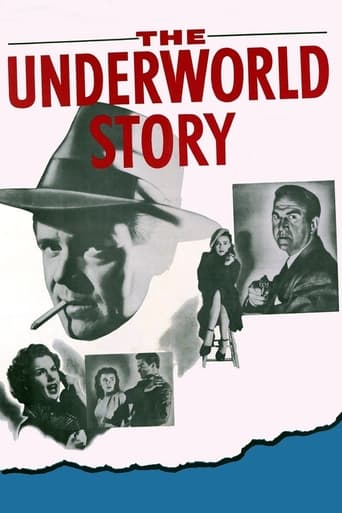

In the inexplicably-titled Underworld Story, amoral reporter Dany Duryea uses a small newspaper to gin up controversy over a murder.After a somewhat slow start in which Duryea's greed and self- centeredness are hammered home, things get interesting with the murder and the arrest of an innocent "negro" played by a white actress. Duryea plays the angles, both for and against her depending on what he thinks will sell newspapers, while other news organizations attack the accused for their own cynical reasons.This is solid noir stuff, beautifully shot by Stanley Cortez, with solid performances, most notably by Herbert Marshall as a morally conflicted publisher and Harold Da Silva as a jovial mobster.The main problem is the script, which becomes increasingly unconvincing from the moment Duryea suddenly flips from sleazebag to noble. Being noble seems to also make him remarkably stupid, a stupidity that is then caught by other characters, like Da Silva, who do things for no other reason than to further the plot.Between the slow beginning and the increasingly absurd end, there is a really enjoyable movie. I almost gave this a 7, but by the end I was feeling to annoyed by the poor plot choices. Still, if you like noir films you should check this out.
... View MoreTHE UNDERWORLD STORY – 1950A rather unseen film, that deserves to be better known, particularly among noir fans.Dan Duryea plays a reporter on a big city newspaper who gets himself blacklisted. He wrote a story that ended up getting a Police witness deep-sixed. He is more or less persona non grata with any big town newspapers. He borrows some cash and buys a half interest in a small New England paper ran by Gale Storm.For Duryea, it is perfect timing. A murder has happened in town, and it involves the daughter in law of big time newspaper owner, Herbert Marshall. Duryea dives in looking to make a big financial score by selling the deal before the wire services do.Duryea, a less than "upright" newsman makes like a salesman as he wheels and deals the story. His new partner, Gale Storm is not in the least impressed with Duryea.The audience knows right off the bat who the killer is. It is the dead woman's husband, Gar Moore. The Police though, are looking for the dead woman's Negro maid, Mary Anderson. And she looks guilty as hell as she had been in the city selling the dead woman's jewels.Duryea sees an even bigger chance at a money making story. He starts up a defence fund for the maid. He hires a lawyer who agrees to split the fund with Duryea. Needless to say some roadblocks pop up for Duryea and his schemes.This is a very entertaining film, with cast and crew all excellent. The direction of Cy Endfield is spot on. Endfield's work includes, THE SOUND OF FURY, HELL DRIVERS, MYSTERIOUS ISLAND, ZULU and SANDS OF THE KALAHARI. The look of the film is equally good with Stanley Cortez handling the cinematography duties.Well worth a watch.
... View MoreDuryea's Mike Reese has all the scruples of a pinball with about that many scheming twists and turns. It's perfect casting for that unusual performer. Fired from a city newspaper, reporter Reese uses mob money to buy into a sleepy suburban paper, where he exploits a sensational murder for private gain. For its time, the movie's about as cynical as they come. Still, this crime drama's a genuine sleeper with few punches pulled until the Code enforced ending that unfortunately isn't very convincing. What the story does show in fairly unsparing style is how corruption can reach into a town's highest levels. The narrative is pretty plot heavy so you may need the proverbial scorecard. But it's an intelligent screenplay, providing plausible motivation for the various misdeeds. I suspect the movie's title comes from the role the underworld plays in doing the dirty work for more respectable members of society, and then exploiting the connection for nefarious purposes (Stanton & Durham). It's the connection between the two worlds that appears to be the main theme. DeSilva plays the mob boss in unusually jovial fashion (perhaps too much), along with occasional hints of snarling menace.I wouldn't expect a cheerleader type like Gale Storm to be in a crime movie, but she does a believable job as the struggling suburban publisher, put into a fix by her recently deceased dad. I kept expecting something to develop between her and the high-powered Reese, but this is not a movie of clichés.As I recall, the film was taken to task for casting a white woman (Anderson) in the important role of the "Negro" maid Molly. Now, there's a question of why the maid would be made a Black woman in the first place since her race is not a factor in plot development. And second, why cast an obvious white woman in the part, which only invites unneeded curiosity. I'm not sure what the answers are, but leftist writer Blankfort and director Endfield may have wanted to make a racial statement that didn't make it to the screen. But whatever the reason, the casting remains a false note in an otherwise thoughtful screenplay.Several notable social themes do emerge. Note how easily a well-meaning public is fleeced by Reese and the shyster lawyer, after offering up their hard earned money to the defense committee. Then there's the town's wealthy establishment that can ruin anyone who crosses them, including Reese and his newspaper. Or the yellow journalism that will print whatever promises to make money. Just as importantly, these key topics play out in fairly subtle, non-preaching fashion.Director Endfield shows here, as in his powerful Sound of Fury, aka Try and Get Me (1950), that given the chance away from his Joe Palooka programmers, he could do social conscience films with the best of them. Note the many careful touches in this film—the shabby people lined up to donate to the defense committee, the defining bust of Napoleon discretely behind editor Lee's (Dunne) desk, Lee slyly opening the door behind Reese despite what he's saying. Too bad Endfield finished his career in England after falling victim to the blacklist.All in all, the movie's not as powerful as Sound of Fury, but it does avoid clichés and remains consistently engaging and unpredictable. Endfield appears fascinated in both films with yellow journalism and how it's used to exploit society, a worthy topic for any period. Editor Reese is nothing if not entrepreneurial in his schemes, with the money-making ideas spitting out as fast as a machine gun. It's an impressive lead performance by the great Duryea. Anyway, except for the occasionally cheap sets and unconvincing climax, this obscure indie production remains a genuine sleeper.
... View MoreWhy 'The Underworld Story'? I guess there are some underworld types present but the emphasis is not on the underworld. It's a story about a newspaper editor who has lost his moral compass and moves to the sticks. This is one very few pictures in which Dan Duryeas' name is above the title, and he does an excellent job. Those of us who count him among our favorite character actors will not be disappointed in his star turn here. Complete with sardonic grin and usual wisecracks, he is in his element as the editor-in-search-of-scruples.It carries the Warner Bros. patina - a gritty crime melodrama with a mix of social commentary and thick-ear rough stuff, and with a curious collection of supporting characters. Howard Da Silva, Gale Storm, Michael O'Shea and Harry Shannon all do themselves credit and Herbert Marshall(?) also manages to fit in.This is a good semi-noir. It starts off as one but switches in mid-picture to straight drama and then back again. Only 90" long, it holds your interest throughout. It may not sound promising but sometimes you can't judge a movie by its title.
... View More